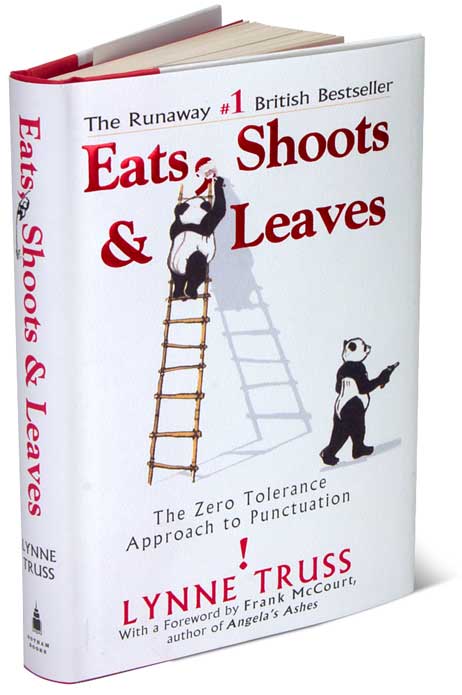
This blog is making me feel extremely self-aware that it seems like all I do is watch movies.
I do other things, I swear. I actually am really busy.
I'm done being self-conscious now. On to better things:
The last book I read was Eats, Shoots & Leaves, by Lynne Truss.
It's a New York Times Bestseller that calls itself the “Zero Tolerance Approach to Punctuation.”
Both witty and educational, this book is a must-read for those of us who still care to keep punctuation alive. The book begins by using a commonly used sentence to demonstrate how punctuation greatly affects the meaning of a sentence:
“A woman, without her man, is nothing.
A woman: without her, man is nothing” (9).
This book tackles the use of periods (called full stops in England), commas, colons, semi-colons, apostrophes, parentheses, question marks, exclamation points, hyphens, dashes, and a few other common punctuations. Each one is given its brief history, famous writers who fancied them, common misuses, and proper forms and uses.
Truss’ wittiness is subtle and well-placed. When noting how a misplaced (or lack thereof) comma can entirely change the meaning of a document, she writes,
“Between the 16th century and the present day, [the comma] became a kind of scary grammatical sheepdog…It tears about on the hillside of language, endlessly organising words into sensible groups and making them stay put: sorting and dividing; circling and herding; and of course darting off with a peremptory ‘woof’ to round up any wayward subordinate clause that makes a futile bolt for semantic freedom” (79).
One of Truss’ most-hated punctuation misuses is misplaced apostrophes. She gives examples throughout the book of humorous, cringe-inducing misuses. After giving many examples of correct usages, she writes,
“I apologise if you know all this, but the point is many, many people do not. Why else would they open a large play area for children, hang up a sign saying, “Giant Kid’s Playground,” and then wonder why everyone stays away from it? (Answer: everyone is scared of the Giant Kid)” (41).
With the wide use of the internet as a means of communication, traditional punctuation has become a mere option for many.
“Before the advent of the internet,” writes Truss, “our punctuation system was very conservative about adding new marks…Anything new is welcome today” (196).
She goes on to describe how symbols like asterisks and brackets are used in place of proper punctuations.
This probably isn’t a book for everyone. To appreciate it, you might need to have a basic love of grammar and punctuation, and let’s face it, not everyone does. There are some, God bless them, who like to write without commas colons apostrophes dashes line breaks and other marks, and who enjoy having their sentences look like the above line.
For those of us who care to keep proper uses of punctuation, however, this book is marvelously insightful and validating. It is also clearly-written and easy to read. I haven’t laughed out loud from reading a book this much since Helen Fielding’s Bridget Jones’ Diary.
Truss quotes author Thomas McCormack from his book, The Fiction Editor, the Novel and the Novelist on the purpose of punctuation, which splendidly sums it all up:
“Punctuation to the writer is like anatomy to the artist: He learns the rules so he can knowledgeably and controllédly depart from them as art requires. Punctuation is a means, and its end is: helping the reader to hear, to follow” (202).
(Note: the book comes with a “punctuation repair kit,” which includes stickers of various punctuation marks, if that’s incentive…)

No comments:
Post a Comment